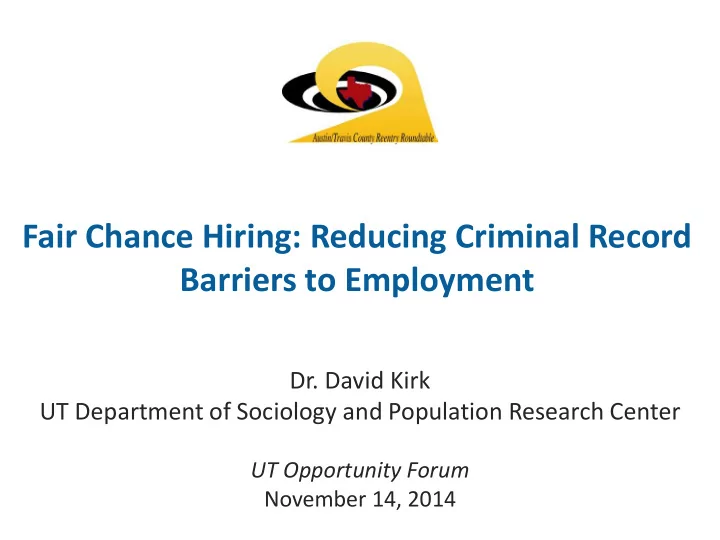

Fair Chance Hiring: Reducing Criminal Record Barriers to Employment Dr. David Kirk UT Department of Sociology and Population Research Center UT Opportunity Forum November 14, 2014
U.S Prison Releases, 1977 - 2013 800,000 700,000 U.S. (excl. TX) Texas 600,000 Number of Releases 500,000 400,000 300,000 200,000 100,000 0 1977 1979 1981 1983 1985 1987 1989 1991 1993 1995 1997 1999 2001 2003 2005 2007 2009 2011 2013 Prison Releases
The data reveals… • 623,000 released from prison each year U.S.: • 850,000 on parole; 4M on probation • An estimated 70M to 100M persons have a criminal record in the US • 74,000 released from prison each year Texas: • 85,000 on parole • 162K on felony probation, 96K on misd. probation • 12M with a criminal record • 2,400 released from prison each year Local: • 2,800 on parole • 16,000 on probation
Disparate Impact
U.S. Male Imprisonment Rate 2013 (per 100,000 population) 3,000 2,500 2,000 1,500 1,000 500 0 Black (Non-Hisp) Hispanic White (Non-Hisp) Source: Bureau of Justice Statistics (http://www.bjs.gov/index.cfm?ty=nps)
The data on spending reveals… • We spend $3.15 billion each year in Texas on TDCJ, which equates to almost $21,000 per prisoner per year. – By comparison, the federal poverty threshold for a single member household is $11,670. • State funding for probation: $300 million. • State funding for parole: $177 million. • Local funding for APD: $369 million.
The data on arrest reveals… According to Austin Police Department arrest data archived on the Krimelabb website: o Approximately 24,000 different individuals have been arrested in Austin so far in 2014 (through the end of September) o 53% of these 2014 arrestees are repeat offenders, and have been arrested at least one other time in Austin since 2007. o Of the individuals arrested so far this year in Austin, 164 of them have been arrested at least 50 times since 2007; more than 2,200 of them have been arrested at least 10 times since 2007. o Why isn’t law enforcement working against these recidivists?
The data on recidivism reveals… Source: Legislative Budget Board (2013), Statewide Criminal Justice Recidivism and Revocation Rates
Relevant Research Questions 1) Does employment decrease the likelihood of recidivism? 2) To what extent are criminal records a barrier to employment? 3) How long does a former offender need to be “clean” (i.e., crime-free) before they pose no greater risk to society or employers than the average person?
Q1. Employment and Recidivism • Uggen, Chris. 2000. Working as a Turning Point in the Life Course of Criminals. American Sociological Review 67:529-46. • Used data from the National Supported Work Demonstration – 3,000+ individuals with an arrest record randomly assigned to a treatment group or control group, where the treatment group received an offer of employment for a minimum wage job (mainly in service or construction industries) • Findings: for individuals age 26 and younger, there was no effect of work on recidivism. But for former offenders age 27 and older, employment led to a 24% decline in the likelihood of recidivism.
Q1. Employment and Recidivism
Q2. The Effect of a Criminal Record Experimental Audit Methodology: Pager (2007) sent matched pairs of individuals (called “testers”) to apply for real job openings to see whether employers responded differently to applicants on the basis of criminal record (and race). Testers were identical except for the presence of a criminal record.
Q2. The Effect of a Criminal Record Black = criminal record Striped/Gray = no criminal record Source: Pager (2003; 2007)
Q2. The Effect of a Criminal Record What about earnings and wages? (see, e.g., Western 2002; Western and Pettit 2005) • Incarceration reduces the wages of formerly incarcerated individuals by roughly 10 to 20% (compared to otherwise similar individuals who have not been incarcerated). • The gap in wages between non-incarcerated and formerly incarcerated individuals grows with time. • Because Blacks and Latinos are disproportionately represented in the prison population, incarceration contributes to wage inequality by race and ethnicity.
Q3. Criminal Redemption The probability of recidivism declines with the amount of time • clean since the last arrest or conviction. Redemption time: how long is "long enough" for someone with • a prior record to remain arrest-free before he or she should be considered "redeemed" by a prospective employer? – Robbery: redemption after 7.7 years for a person arrested at age 18 – Burglary: 3.8 years – Aggravated Assault: 4.3 years Redemption time is shorter for older offenders and those with • short criminal histories. Source: Blumstein and Nakamura (2009); see also: http://www.nij.gov/journals/263/Pages/redemption.aspx
Summary 1) Does employment decrease the likelihood of recidivism? Yes. For former offenders over the age of 26, employment decreased the likelihood of recidivism by an estimated 24%. 2) To what extent are criminal records a barrier to employment? A criminal record reduces the likelihood of an employer callback by 50% for whites; by 64% for blacks. Incarceration reduces wages by 10 to 20%. 3) How long does a former offender need to be “clean” (i.e., crime-free) before they pose no greater risk to society or employers than the average person? It depends upon age and length of criminal history, but less than 10 years, on average.
Recommend
More recommend